Living in the bright and unlikely hope that my Halloween evening will be free from screening movies in need of reviewing — surely, I will have seen The Haunting of Molly Hartley or as I like to think of it Honey, I Sold the Kid to Satan by then — I’ve foolishly barged ahead and staked out my choices for a Halloween double feature I can call my own. What a pleasant change of pace it would be to settle in for that Friday evening with a couple movies of my choice that I don’t have to write about. Whether or not it comes to pass remains to be seen.

Now, if you’re not feeling very adventurous, there’s always the line-up of horror pictures on Turner Classic Movies. They’ve gone all out this year with horror movies all day and night on both the 30th and the 31st. It’s an interesting selection and the Thursday batch includes Night/Curse of the Demon (1957), which just may get my vote for best horror movie of all time. Plus, they’re following it up with Hammer Pictures’ The Gorgon (1964) — a film that so unnerved me at the age of nine that I insisted on turning on the light before crawling into bed with my grandmother to be quite certain she didn’t have snakes for hair. (She didn’t.)
I think I’ll forego the TCM offerings this year in favor of spending an evening with one very old film — James Whale’s The Old Dark House (1932) — and one not so old film — Wes Craven’s The People Under the Stairs (1991). Apart from being examples of one of my favorite sub-genres, the two films have something else in common — they’re about as subversive (in different ways) as horror movies get. And that’s actually saying something because the horror film lends itself to subversive thought.
For those who don’t follow such things, The Old Dark House was a supposedly lost film for what seemed like forever and held place of pride as the most desirable missing 1930s horror picture. Turns out it wasn’t so much lost as mislaid. Universal had it all along, but since they’d sold the rights to J.B. Priestley’s source novel, Benighted, in the early 1960s, they didn’t care much. They owned the physical print, but not the rights to the material, so for all intents and purposes it vanished. Actually, there were two copies—the one in the Universal vault that Curtis Harrington turned up and helped rescue from oblivion (being allowed to search for it was written into his contract as director of 1967’s Games) and a second print that was unearthed by film researcher Raymond Rohauer. That second print is actually better than the Universal one (it’s the one that made the rep theater and college rounds in the late 1970s), but since Rohauer’s estate wants the moon for it, what we have on DVD is the Universal print.

I first caught up with the film when the Rohauer copy was making the rounds theatrically. It was love at first sight. Actually, it was a little more than that because it was the first — and still the only — Universal horror movie I saw for the first time on the big screen. Oh, I’d seen others in theaters, but only after already knowing them frontwards and backwards on TV. The experience was a revelation because when you’re not expecting them, those old shock effects still have the power to make you jump in a theatrical showing. This is one of the things that turned me into a hardcore advocate of not waiting for the home video release of anything. You can have the greatest home theater in the world and it still ain’t the real magilla.
Whale’s film is many things, though it is first and foremost the ultimate old dark house movie, which is only reasonable considering its title. That’s also the reason it works as well as it does. The Old Dark House contains much black comedy, elements of social satire concerning class structure, religious satire and a large chunk of gay subtext, but it never forgets its basic status as a horror movie set in that most venerable of horror institutions—a creepy old house in the dead of night.
Its basic premise is very basic indeed. Travelers — Philip Waverton (Raymond Massey), his wife Margaret (Gloria Stuart) and their cynical young friend, Roger Penderel (Melvyn Douglas) — in the Welsh mountains in the middle of a storm (of course) are nearly killed when the side of a mountain collapses. Seeing lights, they opt—none too cheerfully (“It might be wiser to push on,” notes Philip) — to seek shelter in the titular house. Said house is home to the exceedingly strange Femm family. The door is opened by a brutish butler, Morgan (Boris Karloff), who mutters something utterly incomprehensible (“Even Welsh oughtn’t to sound like that”) before fetching Horace Femm, who lets them in, although the house really belongs to his very unsociable (“No beds! They can’t have beds!”) religious fanatic sister, Rebecca Femm (Eva Moore).

Relations between the Femm siblings are at the very least strained. “My sister was on the point of arranging these flowers,” sneers Horace, scarcely pausing to toss the arrangement in the fireplace. Rebecca, on the other hand, constantly taunts the extremely effeminate Horace for being afraid — and it’s true, he’s terrified of almost everything, which mayn’t be all that unreasonable in light of his surroundings, the moderately murderous (if he’s drunk) butler, and a very dark secret locked away in a room at the top of the house — another Femm, whose very name is not to be spoken. There’s also a 102 year old patriarch, Sir Roderick Femm (played by character actress Elspeth Dudgeon in drag as John Dudgeon) and two more victims of the storm yet to arrive. These are the blustering, nouveau riche Sir William Porterhouse (Charles Laughton) and his chorus girl companion Gladys DuCane/Perkins (Lillian Bond). As the night wears on ever darker secrets are revealed — and, of course, the horrific secret in that little room upstairs.
The Old Dark House is every inch a filmmaker’s film, and this seems to have been a very deliberate choice on the part of Whale. Having invested so much energy into Frankenstein the previous year, Whale was less than thrilled to find so much of the attention he felt was rightly his handed over to Boris Karloff. (It probably didn’t help that Whale appears to have found Karloff something of a pretentious bore, especially once the accolades starting coming in.) There would be no repeat of that this time — the film would be an ensemble piece, Karloff would be relegated to a relatively minor role (with exactly one emotional scene) and the filmmaker would be the star. And it worked, though curiously enough it also worked for Karloff in the sense that his Morgan is quite the most frightening role he ever played.

Whale’s attention was mostly on his supporting cast, though the romance between Melvyn Douglas and Lillian Bond is perhaps the only wholly satisfying heterosexual relationship in Whale’s filmography (that the characters are both outcasts probably helps). It’s not hard to understand why his attention was centered upon the showy grotesquery of Eva Moore’s sexually repressed, nasty-tempered Rebecca and the high camp queening of Ernest Thesiger’s Horace. They’re both astonishingly good characters played by actors who were more than up to the roles. Rebecca probably reminded Whale of the religious “peculiars” from his very working class youth in the town of Dudley. A man who knew how to carry a grudge, Whale always delighted in getting payback by caricaturing those he disliked.
Horace Femm, on the other hand, is simply the kind of prissy eccentric Whale liked. He also liked the actor Ernest Thesiger, whom he would use again as Dr. Pretorius in Bride of Frankenstein (1935). Thesiger affected the exact kind of upper class superciliousness that Whale himself aspired to (Whale spent his whole life pretending he didn’t come from poverty). An expert at needlepoint, Thesiger was known to his friends as “the stitchin’ bitch,” and he revelled in the sobriquet. You get the idea that Thesiger isn’t all that far removed from the snotty Horace, who sneers at everything, but takes perverse delight in the fact that he’s “wanted by the police” (not hard to guess why). Whatever the case, there’s no doubt that he’s the perfect fit for the role and is obviously relishing the experience. “We make our own electricity here,” he reveals at one point, whereupon the lights flicker and he adds, “And we’re not very good at it.” And no one ever got the good out of a line like “Have a potato” the way Thesiger did.

The genius of the film lies in the fact that it constantly undermines its shocks and horrors with comedy for most of its length in a perfect blend. Then when it appears to be headed for a climax that’s equally or even more comedic, the film turns around and plays its final act almost completely straight. When we first see the dreaded Saul (Brember Wills) from the room upstairs, it looks like a joke — here’s a pathetic-looking, obviously harmless little fellow, who must, as he claims, be the victim of familial persecution. And then when no one (except Whale’s camera) is looking, the benign look passes from his face and we’re face to face with truly evil madness — to a degree that we understand Horace’s intructions, “Wait for him downstairs—and kill him.”
Yeah, it’s an old movie and it creaks a little, but isn’t that what an old dark house should do? If anything, it’s creakiness adds to its creepiness in a way that a slicker, more modern film could never achieve.
Wes Craven’s The People Under the Stairs is a somewhat different proposition. Its old dark house is an old dark funeral home and its protagonists are unusual to say the least. Its main character is a 13-year-old black kid from the ghetto named Fool (Brandon Adams), who is railroaded into helping a small-time criminal, Leroy (Ving Rhames), break into the house in question in order to pay for an operation for Fool’s ailing mother. Not surprisingly, this turns out—especially for Leroy—to be high on the list of bad ideas, since the incredibly depraved — and incestuous — couple (Everett McGill and Wendy Robie) who own the house are even worse than local ghetto legend suggests.
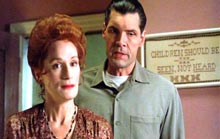
What follows is essentially a warped fairy tale. This is at bottom a kid’s movie — except that it’s an R-rated kid’s movie for adults. And, yes, that’s about as screwy an idea as it sounds. What’s surprising is that it works — not in the least because it’s a fresh take on the old dark house sub-genre that manages to incorporate aspects of urban myths and a surprising socio-political message in the bargain. At the same time, Craven shrewdly preserves enough of the genre conventions to make The People Under the Stairs fall within the old dark house realm. At best, Craven is an uneven filmmaker, but here he scores pretty highly.
The central idea that the owners of the house in question are slumlords — extremely racist ones at that — who have grown insanely rich off the misery of those—like Fool and Leroy—is unusual. It also puts the viewer in the position of being on the side of the criminals, though the film never actually approves of the whole breaking-and-entering scheme. It merely understands it, though Fool’s grandfather (Bill Cobbs), who tells the boy the legend of the slumlords, decries the criminal aspect of the whole thing. By the time, we have a grasp of what’s going on inside the house, the moral question seems pretty immaterial.
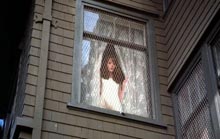
What Fool learns is that the man and woman (only ever referred to — even by each other — as “Mommy” and “Daddy”) have spent years kidnapping children in a search for their ideal of a properly dutiful child. The latest is a meek girl (they’ve had no luck with boys) named Alice (A.J. Langer), who understands far more of what’s going on than we at first suspect. It’s she who explains to fool what’s going on in the house with her “parents” search for a perfect child—“But each one they found turned out bad. They saw things they weren’t supposed to, others heard too much, others talked back. Daddy cut out the bad parts and put the boys in the cellar. They’re given flashlights and food of some kind. I suppose they’re happy in their own way.” These, of course, are the people under the stairs. They’ve been pushed out of sight, had their tongues cut out so that they can’t protest and utterly dehumanized. As Fool so aptly puts it, “Your father’s one sick mother, you know that? Actually, your mother’s one sick mother, too.”
The story takes a turn after Fool escapes from the house with Alice’s help. He decides that he needs to help rescue Alice and the remaining kidnapped children from their evil captors. His actions also serve to cause the neighbors and others who’ve been victimized by their slumlord practices to face up to the duo, leading to a somewhat implausible, but highly satisfying conclusion.
As filmmaking, The People Under the Stairs is unusual. Nearly 70 years earlier Whale mixed black comedy in with his old house horrors, but Craven goes beyond that notion by injecting scenes of outright slapstick. This isn’t the “splatstick” one finds in, say, the films of Stuart Gordon, since the humor never arises from the movie’s gore quotient. Indeed, Craven’s use of blood and guts is almost wholly straight-faced (not always in his favor, because some of the effects are a bit shy of convincing). Instead, he includes actual sequences of pure knockabout that usually end up with “Daddy” being bested by a 13-year-old kid. It mostly works, but it does tend to reduce the sense of menace. That’s probably intentional, since “Mommy” is clearly the brains behind the operation and “Daddy’s” little more than a henpecked, lethal buffoon.
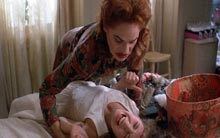
And the dynamics of the “Mommy” and “Daddy” relationship are what’s at the center of Craven’s very politically-minded film. At the time he made People, Craven went on record that the film was his reaction to the Reagan era. That’s actually pretty hard to miss even without his statement, and it contributes to the fact that the film has become more, not less, controversial with the passage of time. There’s never any doubt that “Mommy” and “Daddy” are cartoonish caricatures of Ronald and Nancy Reagan.
Oh, sure, they’re taken to absolutely outrageous extremes, but the connection is unmistakble — and the film is unrelentingly vicious in its attacks on them and the political mindset of the era. The dialogue is often very pointed — “The richer they got the greedier they got, and the greedier they got the crazier they got”—sometimes to the point of clunkiness. The film goes right up to the minute of the immediate post-Reagan era with the people under the stairs being kept “entertained” by a television showing the bombing of Baghdad during the Gulf War. Any doubts as the message being conveyed are dispelled by Craven’s use of Krzysztof Penerecki’s “Threnody to the Victims of Hiroshima” on the soundtrack. How this plays, of course, depends entirely on one’s political views.
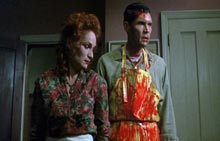
The remarkable aspect of Craven’s film lies in its ability to blend all this material into a unified whole that never loses sight of its horror movie status. His old dark house may not look like much from the outside, but inside it seems to go on forever with an architecture that’s more nightmarishly effective than realistic. In many ways, the film boasts the same kind of innately sinister quality found in the far more avant gardist works of David Lynch — and that may well have been deliberate since Craven’s villains—Everett McGill and Wendy Robie—had played a couple in Lynch’s Twin Peaks. It’s a good fit in a movie where the abnormal has become normal and is accepted and justified by people — out of fear — as being normal. The option, after all, is to end up like the people under the stairs—incapable of protesting because their tongues have been cut out.
If the political aspects of Craven’s movie aren’t to your liking, however, it is indeed possible to just take the film at face value as an entertaining old dark house movie dressed in modern clothes — something that proves that there’s still life in the oldest of all horror sub-genres.
— Ken Hanke
Scanners and From Dusk Till Dawn
Since my Friday will be spent bowing down to the man and working my everyday job until 2 a.m. that night, my Halloween will be spent simply imagining the double feature I’d rather be watching, as opposed to evening I will have dealing with the unwashed masses. But alas, not all hope is lost, since the first film I will be pondering is apropos, as nothing can get you through a 10-hour shift wrestling with the demands of the hoi polloi like pondering the image of exploding heads.

The film I’m speaking of, of course, is David Cronenberg’s Scanners (1981). Part sci-fi, part horror and all gore-a-thon, Cronenberg’s tale of a race of warring telepathic humans isn’t the director’s best work (I’d save that honor for either Naked Lunch (1991) or Videodrome (1983) depending on my mood) but it might be his most viscerally pleasing, due in no small part to the film’s over-the-top splatter. Sure, the amount of gore put on display by Cronenberg might be a turn-off for some, but it’s handled in such an outrageously unbelievable manner that it’s difficult not to love it—or to take too seriously. It’s splatter done right—and if you need examples of how to do it wrong, simply watch any number of second-rate torture porn flicks that have come down the pike in the last few years.
In Cronenberg’s world, gore isn’t about lingering over sadism. No, it’s about being as ridiculous as possible, while still handling everything in the same matter-of-fact, detached manner which has since become an integral part of his modus operandi. Things kick-off pretty quickly, as within just a few minutes we’ve already come to the film’s most iconic scene, that of megalomaniac Darryl Revok (Michael Ironside in what’s probably his best performance) using his telepathic powers to blow up another man’s head. Since at this point, the audience is unaware that Revok is a Scanner (a secret group of people with extraordinary psychic powers), Cronenberg milks the scene for all the tension its worth, culminating in a head popping that’s both surprising and satisfyingly outlandish.

At the same time, it’s also a testament to what a little bit of latex and Purina can accomplish, since the effect was purportedly executed through the simple means of a rubber head, dog food, rabbit livers and a shotgun. It still holds up to this day, especially when compared to the superficiality of much of today’s CGI-driven effects.
The scene, however, is simply there to grab the audience, as the plot moves ahead with the story of Cameron (Stephen Lack, Dead Ringers), a young, inexperienced Scanner who’s recruited by Dr. Paul Ruth (the great Patrick McGoohan) to cultivate his talents in an attempt to stop Revok and his plans for dominating the rest of the human race. From here the film becomes a sort of action, sci-fi, thriller hybrid, with Cameron, Ruth and another friendly Scanner (Jennifer O’Neill) attempting to track down Revok and unravel the mystery surrounding the origins of Scanners.

Of course, this is Cronenberg, so the results of their journey are far from vanilla. We get everything from an exploding telephone booth to psychic unborn fetuses, all of which are filtered through his already quirky worldview. All of this culminates in a climactic meeting of the minds (literally) between Cameron and Revok that revels in its own ludicrous bloodletting and requisite Cronenberg-ian body horror.
Sure, the film’s not perfect. Lack (who doesn’t seem to have had much of a career after Scanners) can be a bit stiff as the lead, but a lot of people would be when placed up against a very bold Ironside and a great big bushy bearded McGoohan. Regardless, the film still remains a fine addition to Cronenberg’s filmography, and a movie that shows his concerns as a filmmaker taking form. The idea that Scanners were created due to pregnancy medication fully fits with the conspiracy theorist bent of some of his other films (such as the evil cabal working behind the scenes in Videodrome), the ability of science to go awry (as with, most notably, The Fly (1986)), his usual distrust and fascination with the failings of the body, as well as — with the film’s climax — his questioning of identity (which he’s still invoking today in work like A History of Violence (2005) and Eastern Promises (2007)). We also get what might be the best idea of why, exactly, Cronenberg makes the movies he does, when a mentally disturbed artist (Robert Silverman, Jason X) proclaims, “My art keeps me sane.”
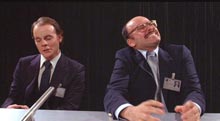
The second movie I would want to be watching if the opportunity was available is Robert Rodriguez’s From Dusk Till Dawn. Released in 1996, Rodriguez’s vampire shoot ‘em up is part of group of the director’s early films from just before he hit his real creative stride with 2001’s Spy Kids. But the fact that the movie isn’t quite on par with, say, Once Upon a Time in Mexico (2003) or Planet Terror (2007) doesn’t keep it from being a hell of a lot of fun.
Working from a script by Quentin Tarantino (who also has a role in the film), From Dusk Till Dawn is really two movies in one, as it’s actually half crime a story that shifts abruptly about halfway into a full-blown vampire flick. I’ve always had this theory that the film would probably work better if the viewer were unaware of the midpoint turn the movie takes, but studio advertising — which pitched the film as straight vampire horror — usually put an end to any surprises in that regard.
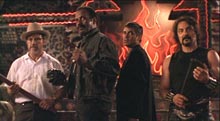
The film opens up with brothers Seth (George Clooney, back in the days where Harvey Keitel still got higher billing) and Richard Gecko (Tarantino) murdering Texas Ranger Earl McGraw (a character, played by Michael Parks, who would later turn up in Planet Terror as well as Tarantino’s Kill Bill: Vol. 1 (2003) and Death Proof (2007)) and getting into a gunfight with a convenience store clerk (John Hawkes, Miracle at St. Anna). It turns out that the Geckos are fugitives on their way to Mexico. In order to sneak over the border, the two kidnap a faith challenged ex-minister named Jacob (Keitel) and his two adopted kids (Juliette Lewis and Ernest Liu).
Once in Mexico, the quintet make their way to a dive bar in the middle-of-nowhere (and manned at the door by a very vulgar — and hilarious — Cheech Marin, whose opening spiel is unfit to reproduce here), where the Gecko brothers are set to meet their contact at dawn and the split up the money they’ve stolen from knocking over a bank, while Jacob and his family are kept there as possible collateral.

It soon becomes obvious that the bar, which is filled with ne’er-do-wells, is shadier than it seems, as we quickly learn that the place is infested with vampires. And this is the point where the film shifts from Tarantino crime flick to an exercise in slick Rodriguez-style action, with a good bit of horror thrown in to top things off.
As vampire movies go, From Dusk Till Dawn is very much revisionist, but still plays around with the usual tropes that traditionally accompany the genre. All this really means is that instead of garlic and stakes through the heart, there are ideas at work such holy water-filled Super Soakers, a vampire being stabbed through its removed heart with a pencil, and a Peter Cushing reference.
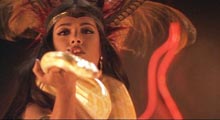
While there is a bit of now dated CGI on display, the creature effects primarily rely on make-up and animatronics. While admittedly, some of it can be a bit hokey, it never betrays the goofy, bloody, violent fun Rodriguez is obviously having, while also retaining a solidity that’s never found in computer effects.
But the real boon to the film is the cast. While the film falls early in his shift towards Hollywood, Clooney still oozes the charisma he’s now known for, while playing well off of Keitel’s cool reserve. The film’s biggest surprise, however, might be Tarantino in the role of Richie Gecko. Usually, Tarantino’s screen presence strikes me as awkward and off-putting, but since his sexually depraved, somewhat creepy character is supposed to be awkward and off-putting, it works. Even Tom Savini, who usually feels like he’s simply just giving an extended cameo whenever he appears in a film, gives his most memorable performance (like there are that many to choose from) as the leather-clad, whip-wielding Sex Machine.
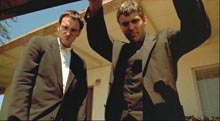
And those are the movies I would be watching Halloween night if I could, but I’m not. But nevertheless, don’t let my lackluster night get in the way of your holiday shenanigans, whatever they may be.
— Justin Souther



Some interesting choices, Ken. All great films for sure. With regard to The Gorgon, Sony just released a ‘Hammer Horror’ two-disc set which includes four films never before released here on DVD, including The Gorgon. Great image quality.
My picks would probably be The Black Cat (the great Lugosi/Karloff vehicle) and probably Evil Dead 2.
With regard to The Gorgon, Sony just released a ‘Hammer Horror’ two-disc set which includes four films never before released here on DVD, including The Gorgon. Great image quality.
Yeah, I ordered it the other day (and in the bargain somehow ended up spending $55 on a complete set of Hal Roach Little Rascals shorts). I caught part of The Gorgon on TCM and I assume it’s the same print, which looked pretty good.
The ’34 Black Cat is one of my “comfort” movies that I defaut to when nothing else appeals.